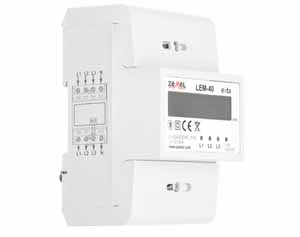Connected_load
The calculation of the connected load for a specific building, facility, flat or manufacturing plant seems to be a seemingly simple matter. However, it is important to consider the total load for all appliances, as well as to maintain an adequate margin of error and to bear in mind several important variables. In addition, we must also remember not to confuse the connected load with the contracted load. Let’s start from the beginning.
What is the connected load?
Connected load is the total electric power-consuming rating of all devices. It is the maximum load of all the equipment and appliances at a particular time over a particular time span. It can be determined based on measurements taken in 15-minute intervals at the times of the highest energy consumption, from which average values are obtained (in kW). When calculating the connected load for a new installation, the sum of power rating of all devices must be considered. In the case of houses or apartments, the most important are heating devices (including water heaters such as boilers), electric cookers, induction cooktops, large household appliances, stoves, and other forms of electric heating (heating films). Of course, in addition to these, we sum up all other, much less energy-consuming appliances, such as small domestic appliances, white goods, laptops, lighting, etc. The total power of these devices (referred to as the installed load) should be multiplied by the so-called coincidence factor, which for a typical single-family house is 0.6. In addition, it is worth adding a safety margin for unexpected power requirements, because sooner or later some new devices will appear; however, this margin should not be too high. The total sum of all these values can be considered as the correctly calculated connected load.
In the case of newly designed installations, the correct estimation of the connected load, i.e., the total power, suggests which type of installation and which type of cabling (cable cross-section specified in mm2) should be used. In fact, appliances that require three-phase power (400V), such as electric cookers or large induction cooktops, are increasingly being used in single-family homes alongside traditional appliances that need single-phase (230V) power. As a result, it often turns out that a given facility needs two separate connections, each with different cabling and power demand.
Connected load and contracted load
The very term ‘contracted load’ directly suggests that it is the load specified in the contract for the sale of energy to the consumer, which indicates how much energy we can draw from the grid. It is most often determined by analysing the amount of annual electricity consumption, if this is possible, or estimated based on the demand measured in 15-minute intervals. If the measurement is particularly difficult, the contracted load shall be assumed to be equal to the connected load . However, the contracted load shall never exceed the connected load

LEM-40
Electricity meter: LEM-40 Situations where the contracted load is over- or underestimated can be problematic. In the case of overestimation, the excess load in relation to the actual consumption is obligatorily covered (the recipient must pay for it) and the fact of not using it is irrelevant. The underestimation is more problematic, as overvoltage problems may eventually force us to increase the electricity load. In the case of enterprises equipped with current transformers (allowing the contracted load to be exceeded), excessive energy consumption may occur, which may result in contractual penalties, often many times higher than in the case of overestimation of the contracted load. Therefore, it is better to slightly overestimate the contracted power and have a certain safety margin than to underestimate it even a little.
The difference between connected load and energy consumption.
The actual energy consumption must always be lower than the connected load. The difference between the actual consumption and the connected load is the margin of error mentioned above. It is needed not only so that the consumer of electricity can use this surplus in the future when the number of electrical consumers in his home increases. This margin is also the safety buffer for all short-circuit and overload protections. This is due to a simple fact: the overcurrent relay trips when the load current crosses the set-point limit of the connected load, which is neither comfortable nor safe. Of course, it is possible to to increase the connected load which, however, will involve additional costs and re-connection to the grid.
Connected loads for single-family homes and flats
As already mentioned, heating appliances have the greatest influence on the connected load. These include electric cookers, hot plates, instantaneous water heaters and boilers or electric heating installations: heaters, heating cables, or heating films. Another variable is the size of the flat or house, i.e., the area to be heated and the number of electricity consumers. As a rule of thumb, a typical flat in a block of flats with district heating (from a studio apartment to a flat with 4 rooms) needs an average of 5 to 15 kW of power to meet the needs of the household. In the case of a detached house with electric heating, this value may only be sufficient for the heating itself; therefore, the connected load should be doubled, but the total value – including all appliances – must not exceed 40 kW. Other variables are the number of inhabitants in a given house or flat and the way they use connected devices. All these variables are related to electricity consumption, and therefore to the estimated connected load, in a directly proportional manner: an increase in the area of the house, the number of inhabitants or the number of consumers translates directly into actual power consumption, which should be within the contracted load, which is more or less the same as the connected load.












